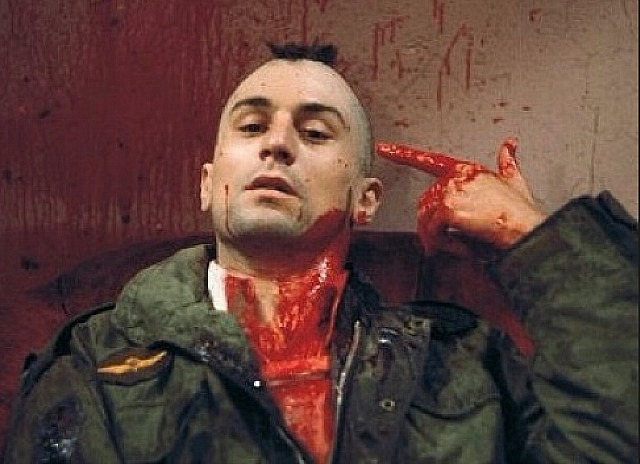In a 6.15 Los Angeles Times article by Randee Dawn, Fran Lebowitz has shared a comment with Pretend It’s A City collaborator Martin Scorsese about Taxi Driver.
Lebowitz: “[Marty] said to me numerous times: ‘You know what ruins Taxi Driver? The color red. The studio wouldn’t give me enough money to correct the color red, and that’s why it’s horrible.’ To which I say, ‘You know what’s wrong with Taxi Driver, Marty? Nothing.’”
HE to Scorsese, Leibowitz: Wrong — the brownish sepia tint during Taxi Driver‘s East Village shoot-out sequence is fucking terrible. It’s always been terrible, and it always will be terrible. And now, after 46 years of saying the sepia brown color is fine and this is how the film was released and so on, Scorsese is suddenly admitting that it looks awful. Which of course is an accurate statement.

On 3.11.11 I ran a piece called “Taxi Driver‘s Brown Blood“. It was about (a) Grover Crisp and Martin Scorsese‘s Bluray restoration of Taxi Driver (it popped on 4.5.11). and more particularly (b) a technical question asked of Crisp by The Digital Bits‘ Bill Hunt.
Hunt asked about the brownish, sepia-tone tinting of the climactic shoot-out scene, which had been imposed upon Scorsese by the MPAA ratings board. Scorsese had naturally always intended this scene to be presented with a more-or-less natural color scheme, in harmony with the rest of the film.
Hunt to Crisp: “Why didn’t you and Scorsese restore the originally shot, more colorful shoot-out scene?”
“There are a couple of answers to this,” Crisp replied. “One, which we discussed, was the goal of presenting the film as it was released, which is the version everyone basically knows. This comes up every now and then, but the director feels it best to leave the film as it is. That decision is fine with me.”
HE response: “There can be no legitimate claim of Taxi Driver having been restored without the original natural color (or at least a simulation of same) put back in. The film was shot with more or less natural colors, was intended to be shown this way, and — with the exception of the shoot-out scene — has been shown this way since it first opened in ’75.
“There’s nothing noble or sacred about the look of that final sequence. The fact that it was sepia-toned to get a more acceptable MPAA rating is, I feel, a stain upon the film’s legacy.”
Crisp explained that even if Scorsese wanted to present the natural color version, the original Taxi Driver negative is gone and there’s no way to “pump” the color back in.
Steven Gaydos 2011 comment: “Jeff’s right that it’s a shame a filmmaker had to alter his film in order for it to be seen in wide release, but according to my in-house expert (Monte Hellman, who oversaw the digital restoration/release of his 1971 film Two Lane Blacktop), if the negative is gone, as Crisp clearly says it is, then ‘you can put the color in but it will never look right, and certainly won’t look anything like the original footage.'”
And that was that.
But two or three years later I came upon the above image of the wounded Travis Bickle, and damned if it doesn’t look like the original probably did before the MPAA stepped in.
I wondered right away where it came from, and I asked myself “if someone could satisfactorily manipulate a single frame from that shoot-out sequence to make it look right and natural, why couldn’t someone manage the same trick for the whole sequence?”












